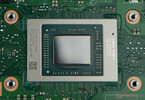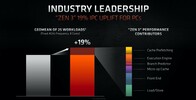AMD Ryzen 5 4500U vs AMD Ryzen 7 5800U vs AMD Ryzen 5 5600U
AMD Ryzen 5 4500U
► remove from comparison
The AMD Ryzen 5 4500U is an upper mid-range, hexa-core processor of the Renoir product family. The APU was unveiled in H1 2020; it is designed for use in thinner, lighter laptops. Its six Zen 2 CPU cores run at 2.3 GHz (base clock speed) to 4.0 GHz (highest Boost frequency possible). Ryzen 5 4500U features the Vega 6 iGPU.
The sole advantage of Ryzen 5 4600U over Ryzen 5 4500U is the thread-doubling SMT technology support. The former has SMT while the latter does not.
Architecture
Zen 2 is a resounding success, delivering massive improvements over outgoing Zen Plus-based processors. Ryzen 5 4500U is manufactured on the cutting-edge 7 nm TSMC process; it is compatible with dual-channel DDR4-3200 or quad-channel LPDDR4-4266 memory. This processor has 8 MB of Level 3 cache.
While the APU uses Zen 2 cores just like the desktop-grade Ryzen 3000-series processors do, Ryzen 7 3800XT included, it does does not have PCI-Express 4.0 support. It does feature several PCI-Express 3.0 lanes for connecting discrete graphics cards, SSDs and other devices. Four PCI-Express 3.0 lanes allow for read/write rates of up to 3.9 GB/s provided a suitably fast NVMe SSD is used.
Ryzen 5 4500U gets soldered permanently on to the motherboard (FP6 socket interface) and is anything but user-replaceable.
Performance
The average Ryzen 5 4500U in our database nearly matches the Core i5-11300H, the Core i5-11320H and also the AMD Ryzen 3 5300U as far as multi-thread benchmark scores are concerned - thus delivering an undeniably impressive performance jump over the outgoing Ryzen 5 3500U.
Thanks to its decent cooling solution and a long-term power limit of 38 W, the Xiaomi RedmiBook 16 R5 is among the fastest systems powered by the R5 4500U that we know of. It can be about 20% faster in CPU-bound workloads than the slowest system built around the same chip in our database, as of August 2023.
Graphics
Just like its name suggests, the Radeon RX Vega 6 graphics adapter has 6 Compute Units (6 x 64 = 384 unified shaders). In the case of Ryzen 5 4500U, this graphics adapter runs at up to 1,500 MHz. The iGPU definitely supports UHD 2160p monitors at 60 Hz; it will have no trouble HW-decoding HEVC, AVC, VP9, MPEG-2 and other widespread video codecs. AV1 is not supported though; such a video will have to be software-decoded for much lower energy efficiency.
Vega 6 will let you play many titles of 2020 and 2021 as long as you stick to low settings and low resolutions. F1 2021 (720p, Low) runs at 32 fps; Outriders (720p, Low) runs at 27 fps, to give you an example or two. As the iGPU has no VRAM of its own, it is paramount that fast system RAM is used.
Power consumption
This Ryzen chip is very energy efficient, as of mid 2022, thanks to the cutting-edge 7 nm TSMC manufacturing process and the mature Zen 2 architecture.
The Ryzen 5 4500U has a default TDP (also known as the long-term Power Limit) of 15 W that can be changed to anything between 10 W and 25 W by laptop makers if required, a right they use more often than not. Clock speeds and performance will change accordingly as a result. By going for the lowest value, it will be possible to use the APU as the heart of a passively cooled tablet, laptop, mini-PC.
AMD Ryzen 7 5800U
► remove from comparison
The AMD Ryzen 7 5800U is a processor for thin and light laptops based on the Cezanne generation. The R7 5800U integrates all eight cores based on the Zen 3 microarchitecture and is the fastest U-series processor at launch. They are clocked at 1.9 (guaranteed base clock) to 4.4 GHz (Turbo) and support SMT / Hyperthreading (16 threads). The chip is manufactured on the modern 7 nm TSMC process.
The new Zen 3 microarchitecture offers a significantly higher IPC (instructions per clock) compared to Zen 2. For desktop processors AMD claims 19 percent on average and in applications reviews showed around 12% gains at the same clock speed.
In addition to the eight CPU cores, the APU also integrates a Radeon RX Vega 8 GPU with 8 CUs at up to 2000 MHz. The dual channel memory controller supports DDR4-3200 and energy efficient LPDDR4-4266 RAM. Furthermore, 16 MB level 3 cache (up from 8 MB at the 4800U) can be found on the chip.
Performance
The average 5800U in our database matches the Core i5-11260H and, perhaps a little disappointingly, the Ryzen 7 4800U in multi-core performance.
Thanks to its decent cooling solution and a long-term CPU power limit of 22 W, the ProBook x360 435 G8 is among the fastest laptops powered by the 5800U that we know of. It can be more than 10% faster in CPU-bound workloads than the slowest system featuring the same chip in our database, as of August 2023.
Power consumption
This Ryzen 7 series chip has a default TDP (also known as the long-term power limit) of 15 W, a value that laptop makers are allowed to change to anything between 10 W and 25 W with clock speeds and performance changing accordingly as a result. Choosing the lowest value would allow one to build a passively cooled system around the Ryzen, however, most laptop manufacturers will do the opposite to extract as much performance out of the chip as possible.
The Ryzen 7 5800U is built with TSMC's 7 nm process for average, as of mid 2023, energy efficiency.
AMD Ryzen 5 5600U
► remove from comparison
The AMD Ryzen 5 5600U, not to be confused with Intel's Core i7-5600U, is a fairly fast Cezanne family processor designed for use in thinner, lighter laptops. The R5 5600U integrates six of the eight cores based on the Zen 3 microarchitecture and is the third fastest U-series processor at launch. The cores are clocked at 2.3 (guaranteed base clock) to 4.2 GHz (Turbo) and support SMT for a total of 12 threads. The chip is manufactured on the modern 7 nm TSMC process.
The new Zen 3 microarchitecture offers a significantly higher IPC (instructions per clock) compared to Zen 2. For desktop processors AMD claims 19 percent on average and in applications reviews showed around 12% gains at the same clock speed.
In addition to the six CPU cores, the APU also integrates a Radeon RX Vega 7 integrated graphics card with 7 CUs at up to 1800 MHz. The dual channel memory controller supports DDR4-3200 and energy efficient LPDDR4-4266 RAM. Furthermore, 16 MB level 3 cache (up from 8 MB at the 4800U) can be found on the chip.
Performance
This Ryzen 5 series chip is a solid mid-range CPU, as of early 2022. Its multi-thread benchmark scores nearly match those of the Intel Core i5-11400H (a much more power-hungry hexa-core chip designed for use in gaming laptops). While not nearly as fast as 12th generation Alder Lake-P processors, the 5600U should be good enough for the vast majority of users.
Thanks to its decent cooling solution and a long-term CPU power limit of 30 W, the IdeaPad 5 Pro 14ACN6 is among the fastest laptops powered by the 5600U that we know of. It can be more than 30% faster in CPU-bound workloads than the slowest system featuring the same chip in our database, as of August 2023.
Power consumption
This Ryzen 5 has a default TDP of 15 W, a value that laptop makers are allowed to change to anything between 10 W and 25 W with clock speeds and performance changing accordingly as a result. By going for the lowest value possible, it is possible to build a passively cooled system around this chip. Most laptop makers, however, will do the opposite to maximize performance.
The AMD Ryzen 5 5600U is built with TSMC's 7 nm manufacturing process for average, as of mid 2023, energy efficiency.
| Model | AMD Ryzen 5 4500U | AMD Ryzen 7 5800U | AMD Ryzen 5 5600U | ||||||||||||||||||||||||||||||||||||||||||||||||||||||||||||
| Codename | Renoir-U (Zen 2) | Cezanne-U (Zen 3) | Cezanne-U (Zen 3) | ||||||||||||||||||||||||||||||||||||||||||||||||||||||||||||
| Series | AMD Renoir (Ryzen 4000 APU) | AMD Cezanne (Zen 3, Ryzen 5000) | AMD Cezanne (Zen 3, Ryzen 5000) | ||||||||||||||||||||||||||||||||||||||||||||||||||||||||||||
| Series: Cezanne (Zen 3, Ryzen 5000) Cezanne-U (Zen 3) |
|
|
| ||||||||||||||||||||||||||||||||||||||||||||||||||||||||||||
| Clock | 2300 - 4000 MHz | 1900 - 4400 MHz | 2300 - 4200 MHz | ||||||||||||||||||||||||||||||||||||||||||||||||||||||||||||
| L1 Cache | 384 KB | 512 KB | 384 KB | ||||||||||||||||||||||||||||||||||||||||||||||||||||||||||||
| L2 Cache | 3 MB | 4 MB | 3 MB | ||||||||||||||||||||||||||||||||||||||||||||||||||||||||||||
| L3 Cache | 8 MB | 16 MB | 16 MB | ||||||||||||||||||||||||||||||||||||||||||||||||||||||||||||
| Cores / Threads | 6 / 6 | 8 / 16 | 6 / 12 | ||||||||||||||||||||||||||||||||||||||||||||||||||||||||||||
| TDP | 15 Watt | 25 Watt | 25 Watt | ||||||||||||||||||||||||||||||||||||||||||||||||||||||||||||
| Technology | 7 nm | 7 nm | 7 nm | ||||||||||||||||||||||||||||||||||||||||||||||||||||||||||||
| max. Temp. | 105 °C | 105 °C | 105 °C | ||||||||||||||||||||||||||||||||||||||||||||||||||||||||||||
| Socket | FP6 | FP6 | FP6 | ||||||||||||||||||||||||||||||||||||||||||||||||||||||||||||
| Features | DDR4-3200/LPDDR4-4266 RAM, PCIe 3, MMX, SSE, SSE2, SSE3, SSSE3, SSE4A, SSE4.1, SSE4.2, AVX, AVX2, BMI2, ABM, FMA, ADX, SMEP, SMAP, CPB, AES-NI, RDRAND, RDSEED, SHA, SME | DDR4-3200/LPDDR4-4266 RAM, PCIe 3, MMX, SSE, SSE2, SSE3, SSSE3, SSE4A, SSE4.1, SSE4.2, AVX, AVX2, BMI2, ABM, FMA, ADX, SMEP, SMAP, SMT, CPB, AES-NI, RDRAND, RDSEED, SHA, SME | DDR4-3200/LPDDR4-4266 RAM, PCIe 3, MMX, SSE, SSE2, SSE3, SSSE3, SSE4A, SSE4.1, SSE4.2, AVX, AVX2, BMI2, ABM, FMA, ADX, SMEP, SMAP, SMT, CPB, AES-NI, RDRAND, RDSEED, SHA, SME | ||||||||||||||||||||||||||||||||||||||||||||||||||||||||||||
| iGPU | AMD Radeon RX Vega 6 (Ryzen 4000/5000) ( - 1500 MHz) | AMD Radeon RX Vega 8 (Ryzen 4000/5000) ( - 2000 MHz) | AMD Radeon RX Vega 7 ( - 1800 MHz) | ||||||||||||||||||||||||||||||||||||||||||||||||||||||||||||
| Architecture | x86 | x86 | x86 | ||||||||||||||||||||||||||||||||||||||||||||||||||||||||||||
| Announced | |||||||||||||||||||||||||||||||||||||||||||||||||||||||||||||||
| Manufacturer | www.amd.com | www.amd.com |
Benchmarks
Average Benchmarks AMD Ryzen 5 4500U → 100% n=41
Average Benchmarks AMD Ryzen 7 5800U → 137% n=41
Average Benchmarks AMD Ryzen 5 5600U → 129% n=41
* Smaller numbers mean a higher performance
1 This benchmark is not used for the average calculation













